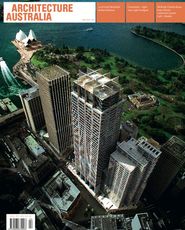The March issue of Architecture Australia is always a special undertaking as it includes the tribute to the RAIA Gold Medallist. This year, it has been a great pleasure and privilege to compile the coverage in honour of Richard Johnson. The buildings undertaken by Richard and his colleagues are highly accomplished works, but what shines through in the tributes is his commitment to making a difference in the public realm, and his belief in the important role that the professional (and the profession) should play in improving public life. In these commitments, Richard conducts himself quietly, but thoughtfully and very effectively. Under his tenacious guidance, commercial buildings include significant spaces for public activity as well as for private interest. Wringing public benefit out of tight commercial programmes is no mean feat, but, as Richard observes, “good public space has levels of enjoyment that have commercial value”. As he demonstrates, one of an architect’s skills is to identify where private and public interests coincide and to make the very most of these opportunities, to the benefit of the urban environment. This is an important skill, one which suggests that a generosity of spirit is fundamental to the architectural enterprise.
This medal not only recognizes Richard Johnson’s outstanding body of work, it also recommends him as an important role model of how to operate as an architect. As Gerard Reinmuth points out in his essay, Richard has been an important mentor to many younger architects. The 2008 Gold Medal will make his contribution more widely known, suggesting he might become a mentor to the profession more broadly and give many cause to reflect on how the profession operates and on how individual members might seek to positively affect public life.
The Gold Medal coverage in this issue is complemented by reviews of four projects that can all be characterized as working hard to find architectural opportunity out of conditions of constraint: tight sites, tight budgets, or tight programmes, and sometimes all three. This is an idea we picked up from an old issue of Architect Victoria, which had the theme “tight”. It seemed a more interesting way to approach a grouping of projects than categorizing solely in terms of building size, type or budget. Of course, there are many projects that could be presented in these terms, particularly as strong smaller works are now also receiving attention through the new RAIA Award category, Small Project Architecture.
We feel that those presented here provide a particularly interesting range – a tiny, joyful office building on a tight inner-urban site, an exquisitely detailed intervention in a small room of historic significance, a pavilion to house water infrastructure, and a low-cost housing project that aims to make “more architecture with less”. Together these projects demonstrate the different ways that constraint can productively operate in the making of architecture, and the contribution that such work can make to the way we think about architecture.
Justine Clark, editor Architecture Australia.















